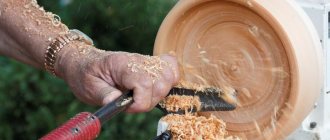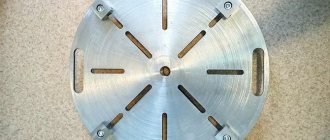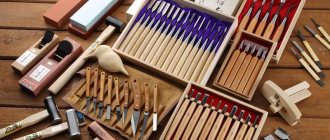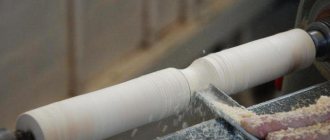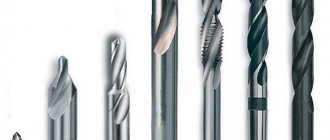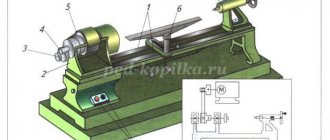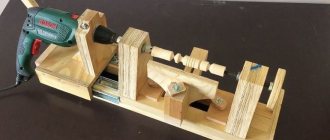Round and cylindrical wood products are used everywhere. Legs from chairs and beds, door handles and tool handles - all these pleasant to the touch and comfortable products are turned on lathes.
Unlike the processing of metal products, where a part, clamped between the headstocks, is turned with a cutter mounted on a special mechanism, the movement of which is controlled by a turner, wood lathes only rotate the workpiece. Grinding is carried out by a person using a special hand tool - turning cutters. With the help of different shapes and configurations of these tools, craftsmen achieve excellent results when working on a lathe.
Description of turning tools
The wood cutter is made of high strength steel.
Although wood is a soft material, the cutting part is subjected to significant loads, and even heats up from constant friction. Therefore, factory cutters are made from alloy and carbon steels, which hold an edge for a long time and at the same time are not too fragile, that is, they do not crumble as a result of a sharp increase in load (for example, when they hit an internal knot in hard wood).
Each cutter consists of the following parts:
- blade – comes into contact with the workpiece and, due to its sharpness, removes a layer of wood;
- working part (body) - one end of it is sharpened to a blade, and the other ends with a shank, the turner holds it with his hand;
- shank - the narrowed end of the working part, onto which a wooden handle is mounted.
The handle is usually made of wood and consists, in turn, of a thick cylindrical base and a narrow neck, on which a metal ring is usually put on, which protects it from cracking when placed on the shank.
Varieties
All devices used for the manufacture, finishing and decoration of turning workpieces can be divided into several general types:
Cut off . The shape resembles a knife, but unlike a regular knife, a turning knife uses only the tip. Parting tools are worked by turning their plane vertically, unlike chisels, which are held horizontally. Using a turning knife, a part of the workpiece is cut off and deep grooves are made.- Chisels . Flat or semicircular objects with a sharpened blade. They select a part of the material, pressing it against the workpiece parallel to the floor or at a slight angle. Thanks to chisels, a beam or log, sandwiched between the headstocks, takes the shape of a curly bed leg or an evenly tapering baseball bat.
- Scrapers . They are used after the product has been given a rough shape. Unlike a chisel, a scraper does not have a sharpened blade - the cut is made using the hard edge of the end. Thanks to scrapers, both decorative and functional complex ring cuts can be made in wood. The most common scrapers are shaped like the letter R.
Various options and their purpose
The variety of cutting tools for wood when rotating on a lathe is very large. Experienced craftsmen create cutters of the shape they consider convenient for the implementation of individual tasks. Therefore, one personal cutter is not similar to another. However, there are standards for factory tools, some of which are basic, others highly specialized.
Reyer
This is one of the basic incisors. It can be recognized by its characteristic shape - the working part of the rail is not flat, but curved, forming a groove. Sharpening is done from the inside of the curve. They work with a rake, bringing it to the workpiece with the groove up.
Thanks to the shape of the blade, this cutter selects wood in a semicircle. Its longitudinally curved shape makes it very durable, making it well suited for rough turning of workpieces. With the help of a reyer you can also make smooth transitions and grooves with a semicircular profile.
The width of the rib ranges from 4 to 30 mm, and the sharpening angle is about 30 degrees.
Meysel
If a reyer is a relatively simple tool, which is intended primarily for rough, rough work, then a meisel is already much more difficult to use.
It is unlikely that you will be able to master it in a couple of days of practice. This cutter is used already when the outlines of the wooden product are formed.
However, for an experienced turner, the use of a meisel gives an even, smooth surface of wood of a given geometry.
The Meisel is a bit like a regular flat hammer chisel, but its blade is angled. Accordingly, the master must have at his disposal at least two meisels - left- and right-handed - in order to process mirrored areas.
Sharpening the meisel can be done either by beveling one side until it comes out flat, or by equally removing the metal layer from both sides. In this case, the width of the blade can reach up to 40 mm, and the bevel angle ranges from 60 to 75 degrees. When sharpening a cutting edge on both sides, the angle should be 20 – 25° on each side.
Shaped
After the main processing of the part in the headstocks has been completed, it is the turn of the figured cut. For this purpose, shaped cutters are used. They can have different shapes for turning grooves, grooves, and select grooves of complex shapes.
Klukarza.
The most common “styles” are:
- Klukarza . The shape of the cutter is similar to the reyer, but has a bend in the working part near the blade. Thanks to this shape, the cranberry can be used for small and complex work; it can reach places where tools with a straight working part cannot reach.
- Comb . It makes parallel grooves and grooves. With the proper level of skill, a thread is cut using a comb.
- Hook . Allows you to make an internal recess with a protruding edge, as well as various curved grooves.
- Crescent or dovetail . Used for turning round and faceted beads.
The process of turning a workpiece on a lathe significantly depends on the sharpening angle of the tool. Small angles (20 – 30°) are intended for fine work.
They remove wood well, but if moved carelessly they can damage the workpiece or break themselves. Large angles (60 – 75°) are intended for rough work with hard rocks.
They can remove less in one pass, but they are not afraid of knots and pressure created by the turner.
About creating with your own hands
Experienced turners make their own cutters for work, not being satisfied with the assortment that is on sale. Plus, it's significantly cheaper. The material used is old tools that have served their purpose: files, needle files, rasps and other flat objects with sufficient hardness.
In order to make a cutting edge, sharpening machines with diamond wheels are used. The easiest way is to make a straight blade - to do this, just sharpen the end of the tool.
When removing metal on a wheel at high speed, you must avoid overheating the steel. Otherwise, the metal will be tempered, and the future cutter will quickly lose its sharpness. Supplying water to the wheel while sharpening is one of the best cooling options. However, if you overheat the cutter during the process, it doesn’t matter. It can be hardened again by heating it red-hot with a propane torch and then running in water or oil.
What wood lathe cutters do you use?
Blades with complex configurations will have to be adjusted manually using thin files and diamond needle files. If the farm has an engraver, it can also be used with conical, cylindrical and spherical burrs (cutters). This way you can get a cutter of any configuration.
After the body is ready, they begin to handle the handle. On turning tools, the shank is increased to accommodate a longer handle for convenience. It is advisable to burn the drilled hole in the handle by heating the shank and inserting it “hot” so that the wood will crack less.
Best sets
DEXX 1834-H11_z01
- type : chisel;
- profile : flat, oblique, curved;
- handle material : wood;
- blade material : alloy steel.
One of the most affordable sets. There are 11 chisel-type cutters, there are both semicircular and oblique blades. Suitable for most small carpentry work.
Factory sharpening is only indicated, so upon purchase you will need to bring the tool into working condition.
STAYER 1831-H33
- type : cutter;
- profile : V-shaped, semicircular, flat, oblique, curved, square;
- reinforced handle;
- handle material : rubber, plastic;
- blade material : hardened steel.
Set with an impressive set of cutters. Some of them almost duplicate each other, so in case of breakdown there will be no problems. The cutters are put on the handle. There are two types: for rough shaping of the workpiece and for fine work.
Electrical tools
Modern carvers widely use electric wood tools, which are lightweight, functional, and portable:
- The electric drill is the main power tool in the market. Drills are produced both mains powered and cordless. Many people, out of habit, purchase a powered tool, although cordless models are more convenient to use. They are lightweight, quiet, and have removable battery packs or come with wall stands with a built-in charger. The range of use of an electric drill is expanded by all kinds of accessories for it.
- An electric jigsaw is a tool that works like a hacksaw and an openwork, or bow, saw. Modern designs are equipped with electronic speed control, the engines are highly balanced and have little vibration. All jigsaws are designed so that the saw blades can be easily changed. A wide variety of different types of wood saws with special tooth configurations are produced.
- a circular saw or circular saw when he needs to cut wood in any direction, quickly, accurately and safely. The main thing is to choose a tool with precise guides and reliable saw blade guards. Some models have a built-in electronic control system that provides a smooth start when turned on and selectable speed.
- An electric planer is ideal for quickly adjusting workpieces to size or for trimming. There are several types of knives that simply change if both edges become dull. The knife block is protected by a barrier, which prevents not only the worker, but also the knives from damage.
- Using electric grinders, you can prepare the surface of a product for polishing or varnishing. There are belt and disc vibratory sanders.
- A manual electric milling machine has taken the place of planes, chisels, tongue and groove sheets and folding tapes. With its help, edges and grooves are cut out in a wooden workpiece, quarters are selected, and chamfers are removed.
Cutters for wood lathe: chisels, knives
Wood lathes are necessary for processing round wooden parts, as well as to give the product a round shape.
Cutters are used for this. They may differ depending on the shape of the cutting part and the method of sharpening.
General information about cutters
Cutters are used to manually machine a workpiece that is rotated directly in a lathe. This tool consists of two main parts: a metal, working and wooden handle. The working part consists of:
- blade - it is this that comes into contact with the workpiece and is subject to regular sharpening at a certain angle;
- body - the part by which the master holds the cutter on the armrest of the machine;
- shank - a tapering place, immediately behind the body, a handle is attached to the shank.
The handle is divided into a base and a neck structure.
Types of chisels
Chisels perform different jobs, and their configuration and design depend on this. Also, each type of cutting tool for a machine has specific sharpening features. To work, a beginner only needs to have two types of cutters: Reyer and Meisel. More experienced craftsmen will need other types of cutters.
how to make chisels for a wood lathe with your own hands.
Reyer
By design, it is a long steel blade with a semicircular cross-section. Designed for rough rough initial processing of the workpiece. Such a cutter is made from a thick plate or groove with a semicircular cross-section.
Working as a reamer, the master gives the workpiece the approximate outline of the future product.
Meysel
Used for finishing wood products. Using a meisel, you can cut the finished part from the remnants of the workpiece. By design, it is a plate with an oblique blade, which is sharpened at the same angle on both sides.
With the help of two main cutters, you can perform almost all turning works on wood of medium complexity. Many experienced craftsmen successfully process the inner surface of wooden parts using a reyer and a meisel.
Shaped
This is a whole group of cutters, with the help of which all other, more complex work is performed on a wood lathe.
Shaped cutters come in the following varieties:
- Chisel – necessary for leveling cylindrical surfaces.
- Comb – cuts grooves and various sizes of threads.
- The hook is necessary to create a cavity at the end of the part.
- The ring is also needed to create cavities.
- Triangle - designed for rough processing of a part and giving it a cylindrical shape. These cutters are sharpened in the shape of a triangle.
More experience is required to work with shaped cutters. With their help, you can give the workpiece almost any shape.
Homemade
To make a tool for a wood lathe, first of all, you need to select high-quality, strong material. This is a high-quality steel grade that corresponds to the required dimensions.
The best option is to use files that have already “worked out” and are not used for their intended purpose. To create a cutter, a metal blank should be sharpened on a special machine and given shape in the main part and in the shank area.
Only the made cutter is first tested on soft wood. If, after checking, no chips or cracks appear on the cutter, then you can begin processing workpieces made from hard wood.
Homemade cutters help to significantly increase the productivity of the process and expand the range of products manufactured on the machine.
Types by functionality
When working on a lathe, it is necessary to have several types of cutters, since these tools, depending on the sharpening and shape, perform various functions, ranging from rough grinding to fine finishing of the finished product.
Rough stripping
A tool designed for such work contains a pair of working edges that mate with each other at an acute angle. This tool is safer than its radial counterparts.
Finish turning
Cutters of this functionality are needed to remove a small layer of chips. Using this tool, you cannot shape the finished product; you can only make the outer surface smooth. Finish turning tools have a tip angle with a right or left sharpening angle.
Shaped
The shaped type of cutter has a semicircular tip. It is designed to work with non-standard surfaces. The configuration of shaped cutters can be very different, depending on the surface being processed and its shape.
Cut-off
It is used only for a single process - cutting the finished product from the remnants of the workpiece.
Boring
These cutters are designed to remove excess material during processing of the product. There is a special ledge in the cutting area for such operations.
Round
Necessary for processing radius workpieces. The working part of such a tool may contain small technological cutters or be radius.
For internal turning
If the cutter is intended for internal turning, then a limiter must be installed on it to regulate the turning depth.
What is included in the knife set?
To fully work on a wood lathe, the master must have a set of tools. These include:
- blunt knives with different blade angles to create complex relief patterns;
- a chisel is the main tool for shaped processing of a product. It can be flat, angular, semicircular;
- cranberry – intended for manual, finishing processing of parts; geismus - a cutter with a bend angle of 45°.
A complete set of tools for a lathe should include all of the above cutters.
How to make it yourself?
The easiest way is to make your own reyer and meisel. To do this you will need a used file or rasp. They should be processed on a sharpening machine and supplemented with a fastening ring on the handle.
The optimal length of the incisor body is 20-30 cm.
The algorithm for creating a cutter is as follows:
- Using a metalworking machine, cut out the desired shape of the future cutter.
- Perform primary turning.
- To give the product strength it must be hardened. To do this, the workpiece is heated to maximum temperature, and then dipped into machine oil to cool.
- Final sharpening of the cutter.
- Mounted on a wooden handle.
When and how should you sharpen?
The quality of the finished product processed with this cutter depends on the geometry of the turning cutter. For a beginning turner, the sharpening angle of the chisel and meisel should be 40°. For reyer – 50-60°.
There are two sharpening methods:
- Manual. It is characterized by low productivity and a complete absence of mechanical labor. It is unlikely to achieve the desired result with high accuracy.
- Mechanical method using special machines with a stone for removing metal.
The manual method is most often used when it is necessary to sharpen a slightly worn tool in a short time. The machine helps to remove defects that appear as a result of operation.
Wood turning cutters
- Wood turning tools are intended for manual processing of a part rotating in a machine.
- They consist of two main parts: a working part (metal) and a handle (usually wooden).
- In turn, the working part can be divided into:
- cutting (blade) - this is the part that is sharpened and interacts with the workpiece;
- body - the main part by which the turner holds the cutter with his “non-working” hand on the armrest of the machine;
- shank - a narrowed part into which the body smoothly passes. The shank is designed for attaching a handle to it.
The handle can be divided into two parts:
- the base is the large part that the turner holds in his “working” hand;
- neck - a small cylindrical part with a metal fastening ring that prevents the handle from cracking when it is pressed onto the shank of the working part.
Types of turning tools
Depending on the type of work performed, wood turning tools have different configurations; the more complex the product, the more sophisticated their design will be, which will determine the specific sharpening of the blade.
Each master can have his own special, exclusive, highly specialized turning tools designed to perform some special work.
Therefore, there is no need to study the design of each individual cutter.
For the successful work of a novice turner, two types will be enough: reyer and meisel.
Reyer - designed for rough, roughing, initial processing of the workpiece. A design feature of this type is a blade shaped like a semicircle. It is made from a thick plate or from a semicircular groove. With the help of a reyer, the wooden blank is given the approximate outline of the future product.
Reyer
Meisel - for finishing the workpiece, giving it its final shape. Also, it can be used to cut off the product from the remains of the workpiece. The shape of a meisel resembles a jamb knife (a plate with an oblique blade, sharpened on both sides at the same angle).
Meysel
With the help of a reyer and a meisel, you can easily perform turning work of medium complexity. Processing the workpiece on the outer surface. In some cases, it is possible to work with the internal surfaces of a part.
All other wood turning tools can be classified as shaped tools. Among them, the most popular types are:
- chisel-scraper - for leveling the cylindrical surface of the workpiece. The shape resembles a straight chisel with one-sided sharpening;
- comb - designed for carving and applying decorative grooves and marks;
- hook – for turning cavities in the workpiece;
- ring - has the same purpose as the hook;
- for rough processing - has a blade shape in the form of a triangle. Designed to give the workpiece a cylindrical shape. This type is the safest of all others due to the small contact area between the tool and the workpiece.
Chisel-hook Chisel-scraper Shaped cutters
Homemade wood turning tools are something of a talisman for craftsmen. Therefore, they prefer to make working tools with their own hands rather than purchase them in a regular store. Although the purchased ones fully meet their requirements, technical characteristics and safe work practices.
Homemade cutters
Making reyer and meisel yourself is not difficult. To make them with your own hands, the most suitable material would be files and rasps that have already “outlived” their usefulness.
This decommissioned tool has the required dimensions, strength, material quality, and steel grade. Using a sharpening machine, the file is given the required shape in terms of the blade and shank.
Then a machined handle with a fastening ring is stuffed. And that’s it, the tool for making wood turning products is ready.
To make wood turning tools, you can use, in addition to files and rasps, car springs or reinforcement bars as materials. They have the necessary hardness. But after making the tool with your own hands, you need to be extremely careful.
Its tests must be carried out on soft wood (linden, poplar), after which the blade must be inspected for chips and cracks.
And only after such a check can turning tools made by yourself be used when working with harder wood (birch, oak, beech).
- Video about homemade cutters
- When making cutting tools yourself, you need to remember:
- The shorter the working part, the more difficult and inconvenient it is to hold it while turning. The length of the body should provide full grip with the hand, plus support on the armrest, plus the distance from the armrest to the workpiece, plus margin for wear and sharpening. Therefore, the initial length of the working part should be at least 20 cm, but a size exceeding 40 cm will cause inconvenience in work. The optimal length should be 20 – 30 cm;
- The shorter the shank, the greater the possibility that it can be torn out of the handle. Therefore, when a cutting tool is made from files or rasps, the shanks are lengthened by 1.5 - 2 times;
- The thinner and narrower the working part of the tool, the greater the likelihood of it being damaged by the workpiece during the turning process. Therefore, at the initial stages of processing, when the workpiece does not yet have an absolute cylindrical shape and runout on the blade occurs, as well as at large diameters, when the cutting force is of great importance, it is necessary to use cutters with sufficient thickness.
- wood turning tools must have a handle no shorter than 25 cm. If it is much smaller, then during the turning process it will be difficult to hold the tool in your hands, not to mention the quality of the work performed.
Do-it-yourself sharpening of cutters
- The quality of the treated surface largely depends on the correct sharpening of the working tool.
- To do this, you will need an electric sharpening machine with a set of wheels of different grain sizes and a velvet bar for manually editing the blade.
- Video of sharpening cutters
- Each craftsman chooses the sharpening angle independently, focusing on his skill as a turner, the hardness of the wood, the quality of the working tool and the final desired appearance of the surface being processed.
- For a novice turner, the optimal sharpening angle options will be:
- for meisel - the bevel itself should be 40° relative to the axis of the working surface and 40° for each side of the blade;
- for reyer – 50° – 60°.
Over time, as the turner's skill level increases, sharpening angles can be reduced to 20° - 35°.
Ideally, in addition to a set of different styles, it is desirable to have cutters of the same type, the same size, but with different sharpening angles. This will make the turner’s work much faster and easier, and will also extend their service life, because there will be no need to constantly resharpen the blades depending on the type of wood being processed.
Blunt sharpening angles are intended for: hard wood, initial (rough) processing.
Do it yourself
To understand how hand tools for woodworking are made, let's look at the manufacturing process of several of their main varieties.
Meysel
This is the main tool used for finishing wood workpieces. In skillful hands, this chisel is enough to create any pattern.
A straight-sharpened meisel is ideal for creating rectangular notches in a workpiece. Its width varies from 4 to 40 mm, the standard sharpening angle is from 22 to 450. The required blade slope is determined by the personal preferences of the master over time.
How to make it:
- We take an old file or any other flat rectangular piece. If necessary, align the working end;
- We grind the cutting part, carrying out primary turning. We use an abrasive wheel, making sure that the blade is processed evenly in thickness without differences;
- We harden if the metal is not hard enough;
- We put the handle.
This type of chisel is easy to prepare and can be used to start creating your own collection of hand tools to gain experience and understand the process.
The Meisel with a beveled blade is more versatile than its counterpart:
- It becomes possible to process round products;
- An obtuse angle is suitable for creating roundings;
- The tool is convenient for processing the end of a product.
Manufacturing is similar to the previous device:
- The blank part is processed to the shape of the future tool;
- The chisel is sharpened at an angle of 70-750, after which the tool must be sharpened.
- We attach the handle. Meisel is ready.
Using a similar algorithm, the remaining angular cutters for a wood lathe are created. Sharpening is carried out only after careful control of the tool dimensions.
Maintaining exact angles when making tools yourself is not necessary. It is enough to adhere to the necessary and convenient proportions and evenness of processing.
Semicircle
The semicircular tip of the chisels allows you to create neat notches when processing a wooden product. To make such a cutter, we mark on the workpiece the outline of the tool along which we cut. After this, we sharpen it in the usual way at an angle of 25...400.
The radius of the chisel affects the size of the recess in the product, therefore for professional production it is advisable to make several cutters with a semicircular tip for different cases.
Groove
After stripping the bark, the wooden trunk is processed with grooved chisels; they are intended for the initial rough finishing of the material and creating a blank for the product.
In addition, grooves are used to cut concave shapes and recesses in frontal turning.
How to make a groove cutter:
- Take a tap to cut a thread of the required diameter.
- We process the metal blank with it at a distance of up to 8-10 cm from the edge, actually cutting off half of the rough product.
- We sharpen the lower convex part of the blade at an angle of 30-400.
Grooved homemade wood turning tools are not easy to make, but it is quite possible to understand the process.
What are the best cutters for a wood lathe?
Wood lathes are used to process round wooden parts or give a workpiece a round (cylindrical) shape. Depending on the shape of the product that needs to be obtained on the machine, wood turning tools are used, which have various types in the shape of the cutting part and the method of sharpening.
Types of hand wood cutters
Basically, when working with wood on a lathe, hand cutters are used, but there are machine options where the tool is rigidly fixed and there is no need to hold it in your hands.
General information
In most cases, turning tools, including those made by yourself, are intended for manual use. The fixed workpiece is rotated by the machine, and its processing occurs by moving the cutting tool along the processed surface with the hands of the craftsman.
A standard hand cutter consists of two parts:
- working fluid made of metal;
- wooden handle for holding the instrument in your hands.
How do hand-held wood routers work and what are they used for?
It has three zones:
- blade - the cutting part (the end of the tool sharpened in a special way);
- body - a metal part that rests against the stand (armrest) of the machine when working;
- shank - the narrowed part of the tool at the opposite end from the blade. A wooden (plastic) handle is attached to the shank.
Classification of wood cutters
The handle of a hand cutter has a base (what the master holds on to) and a neck (a metal fastening ring that prevents the handle from collapsing during operation).
Types of incisors
To carry out many different types of work on the machine, you will need a whole set of wood turning tools. Many craftsmen have their own special tools that they need to carry out a certain type of woodworking, so some of them are made by themselves.
Depending on needs, wood cutters can be:
- cut-off;
- pruning;
- boring;
- shaped.
To perform basic operations on working with wood on a lathe, two main types of cutters are sufficient:
- Reyer - intended for the initial stage of processing the workpiece;
- meisel - to give the product its final shape.
Reyer
Structurally, it is a long steel blade with a semicircular cross-section.
Reyer - designed for the initial stage of processing the workpiece
You can make it yourself from a thick metal plate or a semicircular groove. Sharpening of the working part (blade) is also carried out in the form of a semicircle. A rake is used to give the primary workpiece approximate parameters of the product in rough form.
Meysel
In its shape, this tool resembles a shoe knife - it is a metal plate, the sharpening of the oblique blade is made at the same angle on both sides. It is used to give the product its final shape, as well as to separate the finished part from the workpiece.
about the design and creation of a homemade machine for sharpening knives.
These two main types of cutters allow you to perform basic operations on processing wooden workpieces on the outer surface. In some cases, it is possible to work with them during internal processing of parts.
Shaped cutters
A large family of another type of wood cutters belongs to the shaped category:
- chisel (scraper) - levels cylindrical surfaces;
- comb - for cutting grooves or threads;
- hook - it is used to grind out cavities at the end of the part;
- ring - acts similarly to a hook;
- triangle - the blade is sharpened in the shape of a triangle to give the workpiece a round shape.
Homemade cutters
When making homemade cutters for a wood lathe yourself, you should take into account some features when choosing a material. It must be durable (made of high-quality steel) and comply with the permissible minimum dimensions.
data-ad-client=»ca-pub-8514915293567855″ data-ad-slot=»5929285318″>
Homemade wood cutters for a lathe
The easiest ones to make with your own hands are reyer and meisel. To obtain these cutters, you can use already used files or rasps.
Using a regular sharpening machine, they are given the desired blade shape, and there is often no need to change the handle (provided that the old one is in perfect order).
If there is no fastening ring on the handle, it must be added, as this is an element that increases the safety of working with the tool.
Another suitable material for making cutters with your own hands is reinforcing bars and sheets of automobile springs.
The metal from which they are made has sufficient hardness, but it must be hardened before sharpening. To do this, the resulting cutter blank is heated until red, and then dipped into machine oil for cooling (hardening).
Do-it-yourself cutters should be tested on soft woods (poplar, linden), and then, after inspection for the appearance of cracks and chips, you can start working with harder woods (oak, birch, beech).
The process of turning a wooden blank with a hand tool
Rules for making cutters with your own hands
In order for a homemade tool to justify itself in work, you must adhere to the following rules:
- the length of the working fluid should be within 20-30 cm. This will ensure a reliable grip of the tool and provide enough free space to place it on the support (armrest). In addition, there will be a certain reserve for regular sharpening of the blade;
- the shank must be of sufficient length to securely fit into the handle. Cutters made from rasps or files that have their own shanks require their lengthening by 1.5-2 times;
- the working body of the cutter must be of sufficient thickness to withstand possible impacts during the primary processing of cylindrical workpieces;
- the wooden (plastic) handle of the tool must be at least 25 cm long. Otherwise, holding it in your hands will be very problematic, especially when performing precision work.
Cutters for wood lathe (video)
Algorithm for carrying out the work
The production of any cutting devices is carried out according to a standard algorithm:
- Using drawings and photos, the required shape of the future chisel is cut from the blanks using metalworking machines.
- Primary turning of the product is carried out.
- When the workpiece is processed, the metal needs to be hardened to give the homemade product strength. This way he can process wood of different hardnesses. To do this, the metal tool is heated to maximum temperature and dipped in machine oil until it cools.
Another hardening option is natural cooling at normal ambient temperature. - Final sharpening of cutters for a lathe.
- Wooden handle attachment.
Installation of a wooden blank
Hand tools for wood carving are very sharp. Therefore, it is important for safe operation that the workpiece is secured. They use both special fixing devices or standard clamps, as well as those made independently.
You can do carving on a table, a special stand or a carpentry workbench..
When sculptural cutting, the main condition for comfortable work is the ability to quickly change the angle of the product. To do this, use a special rotary clamp, with which you can quickly change and fix any angle of the workpiece.
A bench vise can be used for wood carving by installing soft jaws on it so as not to leave traces of the metal sponge on the future product. A standard carpenter's workbench vice can be used if you attach a clamp to it, which will continue to hold the workpiece.
For clamping a flat workpiece on the surface of a stand or workbench, a carpenter's quick-release clamp will be convenient. A gasket must be placed between the product and the clamp. Bench stops can be used for the same purpose.
A woodcarving vice is similar to a bench vice , but is made of wood rather than metal. They have thicker cheeks, which are covered with leather or cork to prevent damage to the product. A model vice is an analogue of a metal vice. They have large, wood-lined cheeks that can swivel.
For rigid fastening of workpieces on a stand or workbench, a workbench screw is used. The threaded end of the screw is screwed into the wood, and the other end is secured with a nut through a hole in the stand or workbench.
The carver's stand is a wooden workbench that consists of four massive legs spaced out for secure support and a thick surface. The surface is drilled in order to use fixing devices on it. For stability, the stand must be made heavier by attaching additional weight to it.
